New Year’s Leaves
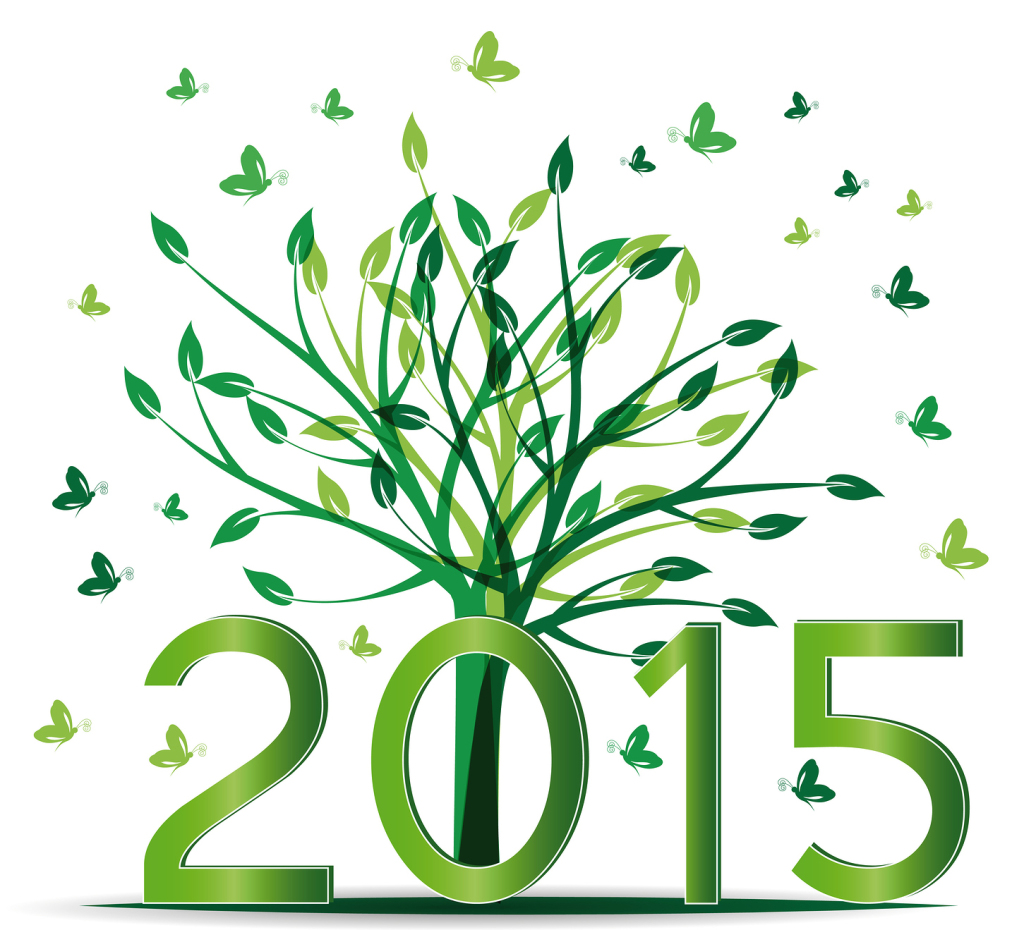
As the old year leaves what new year leaves can I expect to find? Chickweed would top my seasonal list. Locally it’s prime time to find the popular forageable. While it harvests high praise from a variety of foragers it has never been one of my favorites. But, it is nutritious, easy to identify, and for a few weeks plentiful. In some northern climates Chickweed actually germinates under the snow and is ready to go as soon as the spring melt arrives, or what we used to call mud season. Locally it shows up now during the coolest part of the year. I haven’t seen it much south of mid-state. Chickweed pesto is perhaps the best use of the weed. You can read more about it here.
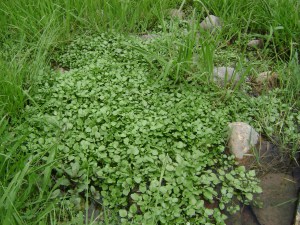
Watercress photo by CookSouthWest.
Also on my list of new year volutions would be Watercress. Central Florida is the winter Watercress capital of North America so it is naturalized from here to there and in between. Oddly it used to be Huntsville, Alabama, where it can also be found in profusion. The problem is it likes to grow in water and much of the standing or even flowing water today is polluted. Where I harvest mine is about one-half mile down stream from the headwater spring of the Wekiva River. But even then one has to be careful because that is also exactly where the deadly Water Hemlock grows. Thus one has to collect watercress carefully… very carefully. Examine every piece carefully.
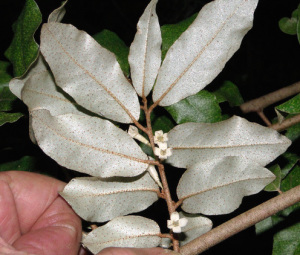
Silverthorn photo by Bobby Hattaway.
Other new year Leaves include seasonal Pellitory, previously covered mustard family members, Sow Thistles, henbit, and true thistles. While not yet ready to harvest on New Years Day the Silverthorn can be in blossom for it fruits in February. It’s welcomed sweetness and Vitamin C in one of the cooler months of the year. Thus Silverthorn is one of those landscape shrubs and escaped ornamentals you start looking for now. It’s very easy to identify: Start looking at hedges with shrubs that have dark green leaves that are silver on the underside with rusty freckles.
One more edible you should begin looking for is Wild Garlic. Late last spring I collected about a gallon of cloves, most of them while teaching classes in Gainesville. I kept them dry and in paper bags until last fall. Then I threw them like wedding rice over a sunny damp area near where I live. Last week while rummage around that area I saw what looked like young reeds but greener and softer. My Wild Garlic had sprouted! Mission accomplished. I didn’t expose the cloves to any chill hours, just kept them dry and inside the house. Now I don’t have to drive great distances to have Wild Garlic.
A couple of weeks ago I was mentioned in The Economist magazine along with Steve Brill, Frank Grindrod, and Iso Rabins. The article was called Salad Daze and was about the growing interest in foraging. Quoted in the article was a geographer for the US Forest Service, Marla Emery. She offered a statistic that my gut instinct doubts but I have no facts to support me nor do I know how she came to her conclusion. She said “roughly 18% of Americans forage at least once a year, up from 13% in 1999.” That would mean, on average, every fifth person you meet has foraged once this past year. That seems overstated to me. I will agree that the interest in foraging has increased but to think a fifth of all American forage seems a bit much. Thoughts? One of the moderators on the Green Deane Forum suggested that included mushroom hunters.
I’ve received some questions regarding Bauhinias, which are found in warmer areas of several states and countries. “Discovered” in Hong Kong, the blossoms are edible and on some, the seeds are edible as well which presents a problem. First, there are several hundred of them — including hybrids — and the second problem is you might not see them often enough to know exactly which Bauhinia you are looking at. It becomes an issue of familiarity, particularly regarding which ones have edible seeds. So it’s a pretty tree, has edible blossoms — at least the purple ones — but when it comes to the seeds you need to be careful and do your homework. To read more about this attractive tree click here.
A common blossom that’s easy to identify is the pansy, which is a violet. There are a huge variety of violets in North America including Field Pansies. Used in landscaping Pansies are attractive, personable blossoms. There are a couple of precautions, however. The first is to make sure the soil they are in — either a pot or bed — is wholesome and that the water they are getting is good as well. If they come from a garden center they might have pesticides on them. The other precaution is a bit more esoteric: Yellow blossoms tend to have a laxative effect.
Upcoming classes: Saturday, January 3rd, Mead Garden: 1500 S. Denning Dr., Winter Park, FL 32789. 9 a.m.; Sunday, January 4th, John Chestnut State Park: 2200 East Lake Road, Palm Harbor, FL 34685, 9 a.m.; Saturday, January 10th, Wickham Park: 2500 Parkway Drive, Melbourne, FL 32935-2335, 9 a.m.; Sunday, January 11th, Dreher Park, 1200 Southern Blvd., West Palm Beach, 33405, 9 a.m.; Saturday, January 24th, Red Bug Slough Preserve, 5200 Beneva Road, Sarasota, FL, 34233, 9 a.m.; Sunday, January 25th, Bayshore Live Oak Park, 23000 Bayshore Rd., Port Charlotte, FL 33980, 9 a.m., meet at the parking lot at the intersection of Bayshore Road and Ganyard Street. For more information about classes click here.
Eat The Weeds On DVD. My foraging videos cover scores of edibles from American Beauty Berries to Yams. The set has nine DVDs. Each DVD has 15 videos for 135 in all. Some of these videos are of better quality than my free ones on the Internet. They are the same videos but many people like to have their own copy. I burn and compile the sets myself so if you have any issues I handle it. There are no middle foragers. And I’m working on adding a tenth DVD. To learn more about the DVDs or to order them click here.
On the Green Deane Forum we post messages and pictures about foraging all year-long. There’s also a UFO page, for Unidentified Flowering Objects so plants can be identified. Recent topics include: Goose Grass 2015, Pressure Cooker Lets Off Steam, Cream Puff, Chocolate Mushie (both mushrooms) Foraging Tools, No. They Are Not Clover, Comfort Food, Nice Seasonal Pots, Ginkgo Tree, Recipe Idea Needed, Flint Knapping, Squash?, Hawthorn Catsup, Your Traditional Thanksgiving, Paw Paw Seeds, Dried Persimmons, Tell You Love Them, Indian Pipes, Amaranth, Mushrooms: Winter Is Here Six Weeks Early, Chicken of the Woods, Coco-Plums?, Acorns All Colors And Sizes, and Turn On The Water. The link to join is on the right hand side of this page.
Two conferences are coming up worthy of your attention. The first is the Florida Earthskills gathering in early February in Hawthorne, Florida. Held over Feb 5-8 it is an opportunity to learn, share and experience sustainable living skills. There’s also an early bird special if you sign up through January 1st. I have taught there for the last two years and there are virtually dozens of classes to sign up for including wild medicine, wild foods, didgeridoo making and playing, buckskin sewing, fire making, yoga, insect study, cabbage palm basketry, bow making, bird songs, atlati throwing, permaculture and a whole lot more, several somethings for everyone To learn more about this Florida Earthskills gathering and sign up go here.
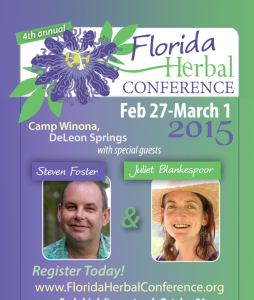 Later in February is the Florida Herbal Conference, Feb 27 to March 1st, organized by Emily Ruff. I’ve taught edible plants there for the last three years and will be there again this year. In fact I plan to spend a lot of time there. It’s a must for all southern herbalists and well as those northern ones who want to escape the cold and study their craft in the dead of winter. It always has interesting speakers and great classes. For more information and to register go here.
Later in February is the Florida Herbal Conference, Feb 27 to March 1st, organized by Emily Ruff. I’ve taught edible plants there for the last three years and will be there again this year. In fact I plan to spend a lot of time there. It’s a must for all southern herbalists and well as those northern ones who want to escape the cold and study their craft in the dead of winter. It always has interesting speakers and great classes. For more information and to register go here.
 January is named for the Roman god Janus who looks both ways before crossing the year. And thus we humans tend to look back at last year and forward to the new year and take stock. I’ve given up on New Year resolutions preferring to make them throughout the year (mid-year resolutions have a better chance of coming true. Actually the greatest chance of success comes when one modifies a habit or behavior rather than eliminating it completely.) I start the new year with a November 10 surgery and a December 10 surgery behind me. There is not one planned for January 10… at least I hope not. Done with that stuff for a while. Thus I have no excuse not to do more in the new year. On the top of my list is to do more private lessons and property consulting. I did not get the scheduling gene so that’s my personal challenge, organizing the dozens of requests I get. So if you have asked in the past and didn’t hear from me, you just might in the months ahead. Or send me another email about it. Happy New Year.
January is named for the Roman god Janus who looks both ways before crossing the year. And thus we humans tend to look back at last year and forward to the new year and take stock. I’ve given up on New Year resolutions preferring to make them throughout the year (mid-year resolutions have a better chance of coming true. Actually the greatest chance of success comes when one modifies a habit or behavior rather than eliminating it completely.) I start the new year with a November 10 surgery and a December 10 surgery behind me. There is not one planned for January 10… at least I hope not. Done with that stuff for a while. Thus I have no excuse not to do more in the new year. On the top of my list is to do more private lessons and property consulting. I did not get the scheduling gene so that’s my personal challenge, organizing the dozens of requests I get. So if you have asked in the past and didn’t hear from me, you just might in the months ahead. Or send me another email about it. Happy New Year.
Fourth Annual Urban Crawl: Every Christmas I hold an “Urban Crawl.” It is a free foraging class in Winter Park. For the last three years it has been on Christmas Eve. But because of surgery I was not quite up to it last week. However I think my fourth Urban Crawl is now possible and will be held on Wednesday, Dec. 31, New Year’s Eve. We meet at 10 a.m. in front of Panera’s, 329 N. Park Avenue (that’s on the north end of Park Avenue, NOT the south end.) There is free parking west of Panera’s in the parking garage, levels four and five. We wander around Winter Park stopping about 2/3 the way for coffee and a bathroom break at the Winter Park Library then work our way back to Panera’s. We’re usually done by 1 p.m. or so. No need to RSVP. Just show up.
If you would like to donate to Eat The Weeds please click here

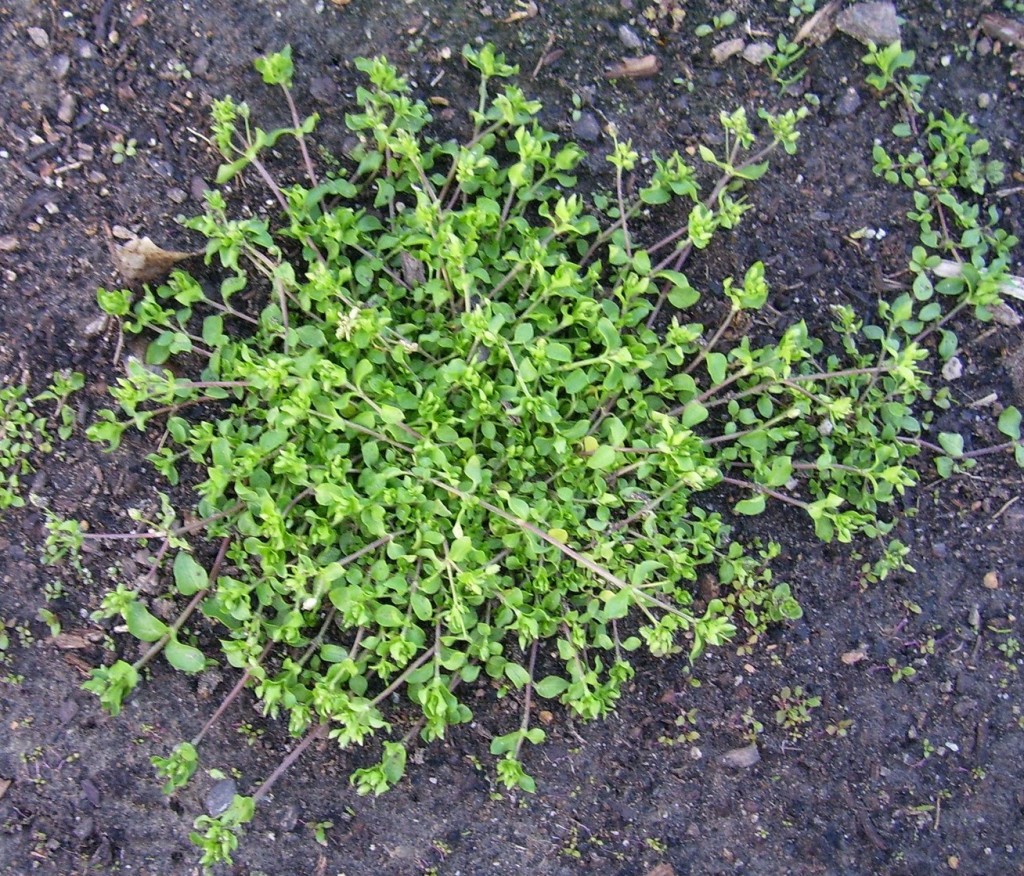
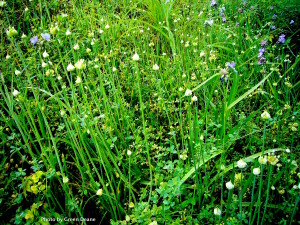
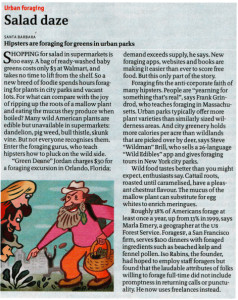
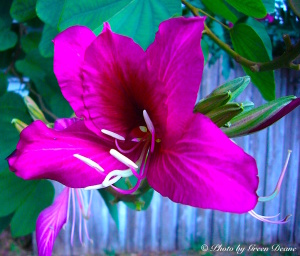
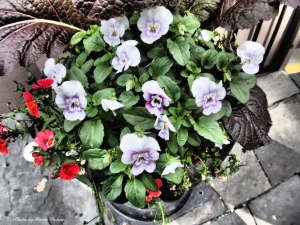
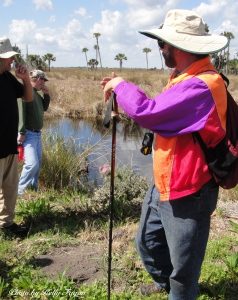
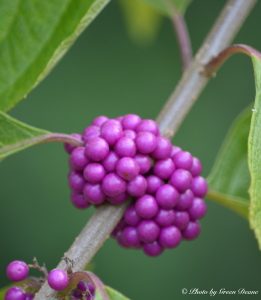

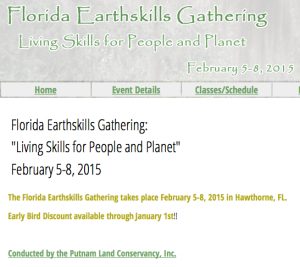
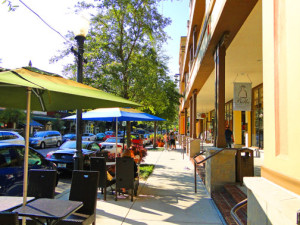

The statement regarding one fifth of Americans forage could be skewed by her definition of foraging. An example would be taking fruit from a neighbor’s tree.
I live in Arkansas, “The Natural State,” in the Ozarks where there is a respect for life close to the land. Yet based on my observations here, I share your skepticism. In fact I’d go so far as to doubt whether more than 2% have noticed the neighbor’s tree, much less the fruit that might be hanging within reach. Among those that have noted the presence of fruit, half are afraid it might not be “real.” Nobody I hang with forages, or seems to have considered it, even though many had grandmothers who did.
Cathy in the Ozarks, I used to buy “Greens” in the powder form (to mix with juice, as a highly nutritious supplement) which was harvested in the Ozarks but can not remember the name of the company from whom I purchased it. Do you know of such a company who harvests such a product in the Ozarks? If yes, I hope you will please share some info so that I may perhaps I can find them again. I google’d key words but couldn’t find them.
Thank you! Patty
Hi Patty,
Try contacting Tina Marie Wilcox, herbalist with the Ozark Folk Center in Mountain View Arkansas. She may know where to acquire powdered greens. She is an author and musician as well with a trio called ‘Herbin League’ (Good Music). She is a plethora of information on local edibles, foragers and more.
Best Regards,
Chaz Mikell
Here in Mobile, Alabama we have dew berries, a prostrate black berry variety that grows everywhere. Almost everyone I know will at least reach down and eaten a few as they mow the lawn. There are embankments at the side of the road where entire families will pick and freeze gallons. Most of these people may not consider themselves foragers though, it depends on how loose the definition is.
Glad to hear you are recovering and still among the kicking. Happy New Year, or as we aging hippie-types say: “Have a cool Yule and a frantic First.”
I love chickweed, Deane. I make two kinds of soup; one is derived from the other. Chop a fist full of clean chickweed and add it to a pot of 2TBS sauteed onions. Wilt the chickweed and then add chicken broth – about two cups. Bring to a simmer and let it go for 10 minutes. Then, with an emersion blender, blend the mix until few, if any, leaves of chickweed remain. Eat. Now if you want to “French” it – add heavy cream to your finished brew and you have another delicious soup. If you want to doll it up, you can add a few more fresh chickweed leaves to your finished brew.
Hi Dean
I live in northern Utah. So far we have had a mild winter till now! Our chickweed is now covered under a blanket of snow. We forage on our property , I juice the chickweed with dandelion , purslane, yarrow and some occasional comfrey leaves.
Utah is kind of a mecca for companies that manufacture herbs, essential oils , supplements etc. Happy New Year to you Dean, really love your website, very informative!
Happy new year Green : I hope you’ll still grow stronger and stronger. I like chickens because they like chickweeds as I do. As for the little birds here at my locality, I have to worry about because they pinched my only two sprouts of chickweeds from which I thought to produce new generation of the plant later when they may give birth to seeds. Nevertheless I’ll try again to grow the useful plant when I find again some seeds. I was introduced to the plant by the well guidance and clearly explained article of yours “Chickweed Chick”. After making sure it was the right plant as described, I rejoiced eating it and had written a brief receipe . That happened when I was visiting my son in Southampton – UK – end of 2013, beginning of 2014.The plant I found was growing under an old oak tree in a back garden in a residential site off Spring Road. The “win win, very nutritious and back garden barometer is worthy of repeating careful attempt to grow again for my benefit and my people.
One fifth huh? Since I’ve been foraging (or learning about-2 years), I have yet to run into anyone who eats anything from the wild. In fact, most people look at me like I’m crazy when I talk about foraging.
Just the other day, my daughter said that her daughter had a dandelion flower, and wanting to eat it because grandpa did. She said, I had to stop telling them about that stuff. That’s how the general public I see thinks about wild edibles. As if they’re bad for you.
The dandelion flower I ate however, had no taste, but the texture was terrible, but tolerable.
Coming from a guy who doesn’t like many veggies, much less raw, my Christmas wish came true, as I got a Ninga food processor. Now, I cut up an apple, and mix in nettles, maybe some clover, even dandelion leaves, that is if I can find any this time of year. Anyway, point is, if I don’t like something, I can juice that sucker and gulp it down. My interest in wild edibles is the nutritional value, and we all know, you get the most nutrition when something is freshly picked and raw (not cooked to death). I am bound and determined I’m going to benefit from wild edibles one way or the other.
Greene, I like how you harvested your garlic, and replanted it in your yard. What I have been saying the whole time is people should collect plants when foraging, or seeds, and cultivate it in your garden, for your use. So many things we can control in our own gardens. Wild edibles grow so well without adding lots of amendments to the soil in the first place, as long as they get the conditions they need. Now, I plant nettles, ground cherries, yarrow, chickory, amaranth, and yes, I will plant my own dandelions (not that I have to). Dandelion roots make great coffee. Well, the sky is the limit, isn’t it? I also plan to spread seeds from some of my collection, that I don’t find too much here in the wild, in hopes that it may catch on, and let nature take over and reestablish certain plants in my area. I’m rambling on again, sorry (I could talk all day to anyone who wants to talk wild edibles) lol
The 18% forging thing is doubtful as WE define foraging, but if you count those “U-Pick” fruit farms, the neighbor’s (or your own) tree/garden, etc. you might get up to 18%.
Also, do they count meat? – Hunting, fishing, etc. THAT would definitely bump it up to 18%.
And then there’s eggs gleaned from your own (or your neighbor’s) chickens.
They may also count “borrowing” a piece of fruit or two from regular old commercial farms.
Who knows. 🙂
I love this site and the DVD’s I purchased from you Dean. I forage and I collect medicinal herbs as well. I use to live in central FL and 16 years ago, we moved to the App Mountains. I love it here and have a huge verity of wild food and herbs on my property. I will be moving back to FL in a few months though. I’m sad about leaving the plants I love here, ie burdock, ginseng, and my favorite, Jerusalem artichoke. BUT, I’m looking forward to FL Betony, and quite a few other plants I have learned about because of your generosity in sharing your knowledge.
Thanks Dean!!!
OH ! And I forgot, I doubt that that many people have foraged for food outside of a grocery store.
I see three possibilities concerning that “18%” statistic: (1) foraging definition — most Americans use alternative medicine when you include prayer in that definition, so perhaps 18% of Americans “forage” if they pay to pick fruit on a farm or try one mulberry, etc.; (2) selection bias — maybe the study was rural or in Hawaii, where edibles (e.g. fruit) are more obvious and thus foraging is more common; (3) just plain wrong — maybe it’s 1.8%
Like others, I don’t know anyone who forages around me (expect for the idiot who harvested all the ramps, wiping out the supply forever). Hopefully Marla Emery, the geographer at the US Forest Service, can explain.
Christopher, I think it can take up to 18 months for ramp seeds to germinate, so maybe some ramps will still germinate.